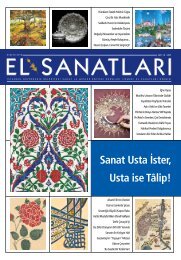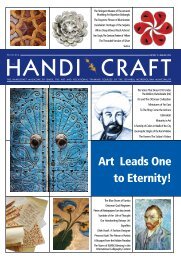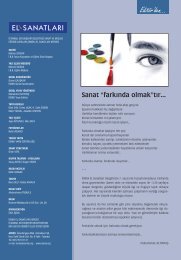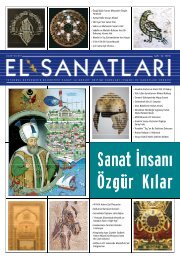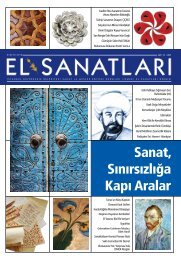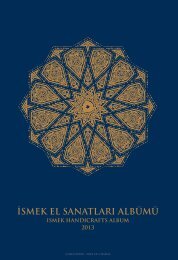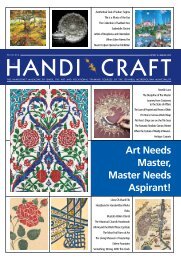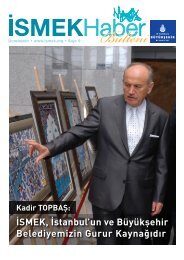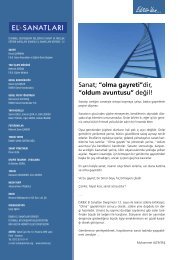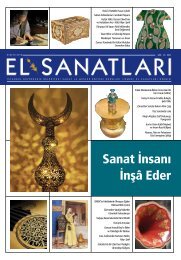Download Link - Ä°SMEK
Download Link - Ä°SMEK
Download Link - Ä°SMEK
You also want an ePaper? Increase the reach of your titles
YUMPU automatically turns print PDFs into web optimized ePapers that Google loves.
in 1803. During Sultan II.Mahmud’s period, high-ranked<br />
military officials’ and low-ranked soldiers’ badges was<br />
consisting of crescent-star symbol, sun, crescent, marines’<br />
badges was consisting of measuring instruments, dividers<br />
and anchors, and some of the military documents has<br />
had arm drawings on them consisting crescent-star symbol.<br />
“The only example that symbolizes Ottoman Empire<br />
with separately usage of Sultan’s signature, the star and<br />
crescent, and coat of arm from one another in one theme,<br />
is a charter from Sultan II.Mahmud period. This charter is<br />
about 149.5 cm tall, and 52.5 cm wide, and it is written<br />
with a style called “divani” 3 and in the days between 26th<br />
of February and 6th of March in 1838.”<br />
The common characteristics of these arms include frequent<br />
usage of tools that shows the militarist side of the<br />
State, and the usage of Sultan’s signature, the star and<br />
crescent all together. Tanzimat Medal, designed by the<br />
Belgian engraver in 1851, is closer to the standard arm.<br />
Sultan’s signature on the top of the medal, 12-radiant<br />
shield below that, two books placed on top of each other,<br />
horn of plenitude, starboard, single and double-headed<br />
halberd, European style sword, bayonet rifles, three cannon,<br />
armor and scales on the left side are tools that have<br />
not been used in previous arms, and these have brought<br />
a new aspect to this medal. 12-radiant star between two<br />
crescents stands in the middle of this charter.<br />
is relatively bigger compared to other seals. While there is<br />
a crown mostly used by western countries in the upper<br />
part of a circle, lower part of the circle consists of a crescent,<br />
a star of David, and Padishah’s signature. However,<br />
the outside of the circle includes guns, drums, standards,<br />
banners, halberds, arrows, bows, spears and horns. In<br />
the medal of Vaka-i Mısriye issued in 1801, Sultan III.Selim’s<br />
signature, and the star and crescent have been used.<br />
There is a coat of arm located in the upper right part of<br />
Sultan III.Selim’s portrait drawn by Konstantin Kapidagli<br />
Sultan’s tughra stands in the middle of the coat-of-arm<br />
used by Sultan Abdulmecid, and it is symmetrically surrounded<br />
by militaristic symbols. Bosnian Medal printed as<br />
both gold and silver in 1850, has Sultan’s tughra located<br />
on one side, and the moon facing to the right and five<br />
pointed star on the other side. Legion medal was given to<br />
Sultan Abdulmecid by France, and afterwards British "Order<br />
of the Garter" medal was given to Sultan Abdulmecid<br />
by the Queen Victoria of England in November 1, 1856.<br />
According to Order of the Garter tradition started by King<br />
III.Edward in 1346, the person or government awarded<br />
with an Order, need to remain the Order in Saint George<br />
Church in Windsor Palace, London.<br />
Since there has not been a standard coat of arm of Ottoman<br />
Empire up until then, Queen Victoria instructed<br />
an expert engraver named Prince Charles Young to prepare<br />
an arm for Ottoman Empire in Istanbul. The expert<br />
starts to research with the help of an interpreter named<br />
Etyen Pizani, and the first draft including reign’s quilted<br />
turban, tughra, sanjak of the star and crescent, and crest<br />
is designed. This arm designed in 1 year, and approved by<br />
Sultan Abdulmecid is hung to the walls of Saint George<br />
141



